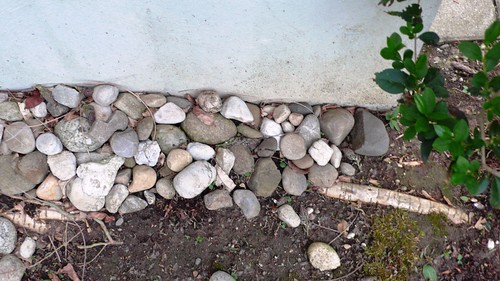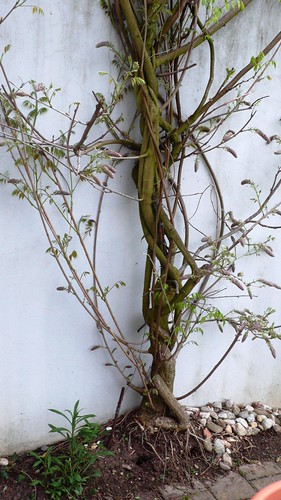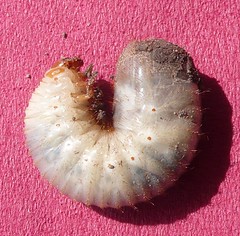
This is my wisteria - a photo taken some time last year in May when it was full in bloom. Our apartment is in a small estate on the ground floor and we have a garden each side instead of a balcony. There was an arrangement made in the plans for a creeping plant, the trellis work was already there, so we decided on a wisteria. Unfortunately we did not realise that a wisteria likes to climb, likes to stretch out and take over anything near bye. Over the years we have constantly trained the wisteria that he has not climbed up the wall of the building or built a thick curtain in front of our windows by pruning and cutting. The wisteria also decided to take the neighbours balcony in charge on the first floor. She was quite happy as she found it a nice plant to have growing through the holes in the metal, but we cut it back and informed that it would not just grow, but decide to weave its stalks into the metal and probably eventually would crush the complete framework. This is the basis of the problem.
This year Spring arrived after a long snowy Winter. The garden showed itself after the layer of snow and ice and my wisteria appeared again. However, I notice something rather strange. First of all I saw this.


When it was first planted I was even worried that it would not survive. It had a thin stalk and the leaves started wilting. This is the result after nine years. A wooden trunk. well many wooden trunks, very thick and very strong. We decided that the gardener should pay us a visit to explain if this would be a danger to the wall and the surrounding tiles. We were worried. I even almost lost a night's sleep. Today the gardener arrived and gave up the verdict. After a close inspection of the roots, he said an immediate danger was not there. The roots were a soft material and somehow the root intelligence of the wisteria told it to grow in a direction where there was no danger.
I told the gardener it seems that the whole plant was lifting itself upwards and not going downwards. He took a close look at the immediate roots and saw the two holes in the earth right and left of the main stalk and asked if we had mice. I could say absolutely not, unless my cats brought them as a present from the fields. He said the two holes were probably mice holes as they extended quite a way down. He reassured us that the wall was not in danger and that we have nothing to fear. If we would want to get rid of the wisteria this would be no problem. The gardener would cut through the trunk and put some sort anti growing enzyme on the top of the root. This would stop any further growth, and the roots would just die a slow death in the ground.
After a discussion we decided to keep the wisteria where it is for the time being and have a rethink in Autumn when it makes its Winter sleep. Relations of ours also have a wisteria. They have a house and it has now taken over the complete wall of the house, growing and covering two floors. Another problem with this stupid climbing attacker is that it is not able to keep its leaves. They all fall off in Autumn, which means days of sweeping until they have all disappeared. The mess from the flowers is also an annoyance. I still am not sure whether to condemn my wisteria to death by poison and beheading or not.
Otherwise my garden seems to be behaving quite well. The normal ants, snails and slugs are moving in slowly and seem to be enjoying the fresh earth. I dug over a new flower bed this afternoon and found two baby June bugs, I think they are known as weevils.

No comments:
Post a Comment